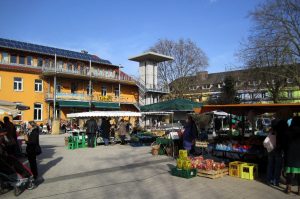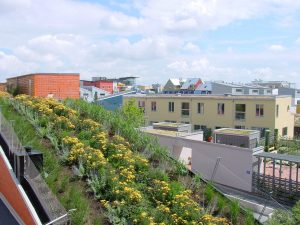1
Christopher Luederitz and Beatrice John, Leuphana University Lüneburg, Germany
The “WHY” – Sustainable transformations of urban environments
“Cities are the abyss of the human species” wrote Jean-Jacques Rousseau in 1762 (1972, p. 59). His description of human life in urban environments is widely echoed in today’s view. Cities are held accountable for producing human ill-health, contributing to climate change, and threatening the diversity and viability of life on Earth (i.e. Grimm et al., 2008). Yet, cities are also considered to have advantages compared to rural environments. They function as innovation hubs and enable material and energy efficiency (Weisz & Steinberger, 2010; Glaeser, 2011). Moreover, well-designed cities promote green and blue spaces, i.e. urban parks or rivers, benefiting the well-being of humans and nature. This is why cities have to play a pro-active role in addressing sustainability: the integrated challenge of economic development, ecological integrity, and social justice.
Current development trends provide evidence as to why sustainability transitions of urban environments are urgently needed. Further, substantial knowledge exists on what should be achieved to move towards sustainable cities. Today, around the world solution-oriented initiatives are shaping such places, which indicate how transformations can be initiated, nurtured, and reinforced. In this chapter we present guiding principles for sustainable urban development and revisit how urban neighborhoods can transform cities and navigate societies towards sustainability.
The “WHAT” – Guiding principles for sustainable urban development
Sustainability principles guide actions that work towards the vision of an ecological integrated and socially viable future (see box 1): They (i) provide a universally functioning compass for practitioners, (ii) demarcate core objectives, and (iii) describe key actions to move towards sustainability (Gibson, 2006; Luederitz, Lang, & Von Wehrden, 2013). However, instead of offering blue prints for well-functioning urban environments, they depict the essential dynamics and features that a sustainable city comprises. Principles break down the complexity of sustainability into small, manageable chunks elaborating on the city’s way of being and functioning, its physical features, and its soul and spirit. Thus, implementing guiding principles requires contextualization to the local specifics that drive the development path of a particular urban environment (Luederitz et al., 2013).
Human-environment integrity
Create integrated urban ecological systems that support and protect the life support functions of existing ecosystems Develop the city with regards to local settings and conditions, harmonize development with the given landscape, historical background, social significance, economic situation and political factors. Reduce the negative impacts and enhance the positive effects of urban environments on their surroundings.
Human well-being
Ensure that all inhabitants have enough for a decent life and have adequate access to resources and opportunities for improvement. Develop self-sufficient and walkable mix-use neighborhoods, reanimate the center, upgrade public places, reinvigorate the local economy, and promote sustainable business opportunities. Tackle social exclusion and ensure that the integration of marginalized stakeholders promotes positive social relationships.
Intra- and intergenerational equity
Design for mixed-income, affordable housing and consider the design needs of the elderly and disabled to ensure social inclusion. Avoid gentrification, consider demographic change and the needs of future residents. Provide access to good public transport for all social strata and reduce motorized individual transportation. Develop contiguous, well-connected compact neighborhoods around nodes of varying sizes and avoid urban sprawl.
Resource maintenance and efficiency
Better understand energy, material and nutrient flows of cities, reducing the overall consumption and ensuring efficient use. Cater for ecological responsible and resilient energy systems and comprehensive water management systems. Avoid pollution, eliminate toxic materials, and reduce waste. Improve resident’s consumption patterns and living standards but also the construction and disposal of the built environment in order to prevent leakage effects.
Democratic governance
Empower all social strata to participate in neighborhood and city relevant issues. Integrate administration, market and customary efforts, and personal decision-making practices. Enable stakeholders to understand environmental characteristics, enhance transparency and enable better-informed deliberations. Provide for places for interaction and education and offer sustainability related teaching programs for different age groups.
Precaution and adaptation
Develop resilient urban environments and ensure iterative and adaptive processes. Acknowledge constant change to maintain functionality, adjust responses to internal and external processes. Welcome diversity in nature, designee and inhabitants. Encourage neighborhoods as incubators of change and convey sustainability to the wider city environment reinforcing the ongoing development.
Box 1: Guiding principles for sustainable urban development. The six principles are based on the seminal work of Gibson (2006; et al., 2005) and research on their contextualization for urban environments conducted by Luederitz et al. (2013) and John et al., (2015). An additional principle developed by Gibson (2006, p. 174), refers to “immediate and long-term integration” emphasizing the need to apply the six principles simultaneously.
The “HOW” – Creating sustainable places in unsustainable cities
A city is more than the sum of its parts. Attaining the ‘sustainable city’ requires that its individual components on different levels already foster sustainability. Particularly important is the neighborhood as the nucleus of a city, which is considered key in creating sustainable urban form and governance arrangements that encourage and enable sustainable lifestyles of urban inhabitants (Luederitz et al., 2013). Over the last two decades, the development of sustainable urban neighborhoods has gained increasing attention in research and practice. Sustainable-oriented neighborhoods are mushrooming around the world. While prominent frontrunners have set the stage, i.e. BedZED in London (Chance, 2009), best-practice examples are found in many places and contexts around the world (i.e. Fraker, 2013; Joss, 2010; Rauland & Newman, 2015). For example, the well-known ‘Vauban’ neighborhood (Freiburg, Germany) was founded in 1994 through a bottom-up planning process and is characterized by plenty of parks and public spaces, overall increased living density, as well as low car ownership (Field, 2011). In contrast, the ‘Bo01’ neighborhood in Malmö, Sweden was developed through strong leadership of the municipality (from 1994 onwards), which continues to transform the former industrial harbor into a green and vibrant community. It is one of the first neighborhoods to be fully powered by renewable energy on site (Foletta, 2011) (see images below).

equity in a traffic-calmed zone in
Vauban, Germany

framers market in Vauban, Germany, Images:
http://www.vauban.de
Cases such as Vauban and Bo01 provide substantial lessons about the implementation of sustainability principles. They indicate how principles can be meaningfully contextualized and elucidate the shortcomings and advantages of transforming unsustainable places. Structures (objectives) and processes (actions) are at the core of this change. First, the architectural paradigm of “form follows function” can be reinterpreted as the need for structures that shape sustainability behaviors and practices. Second, alongside the administration’s tasks, citizens themselves can be seen as active, individual forces with capacities as well as responsibilities of self-organization (John & Kagan, 2014). For example, community driven innovations of urban gardening without the necessary administrational and structural freedom are unlikely to spread. Generally, evidence derived from best practices can and should be used for informing and advancing principles for other transformational sustainability projects.


Guiding principles as navigational tools for urban sustainability transitions
Sustainability principles can navigate societies towards ecologically integrated, socially just and economically viable futures. As navigational tools, they require sustainability enthusiasts to know and engage with the story of their own city and local specificities. Thus, sustainability principles help to guide the vision that neighborhoods want to develop and how to prepare for their journeys. However, as a working list they require continuous advancements closely connected to best-practice cities in order to learn about shortcomings and advantages of solutions. Cities might be the abyss of today’s societies, yet they also offer effective levers for change, which can enable societies to build the urgently needed bridges to sustainable futures of urban environments.
References
Field, S. (2011). Case Study: Vauban. Freiburg, Germany. In N. Foletta & S. Field (Eds.), Europe’s Vibrant New Low Car(bon) Communities. New York: Institute for Transportation & Development Policy.
Foletta, N. (2011). Case Study: Västra Hamnen. Malmö, Sweden. In Europe’s Vibrant New Low Car(bon) Communities. New York: Institute for Transportation & Development Policy.
Fraker, H. (2013). The Hidden Potential of Sustainable Neighborhoods. Washington, DC: Island Press. doi:10.5822/978-1-61091-409-3
Gibson, R. B. (2006). Sustainability assessment: basic components of a practical approach. Impact Assessment and Project Appraisal, 24(3), 170–182.
Gibson, R. B., Hassan, S., Holtz, S., Tansey, J., & Whitelaw, G. (2005). Sustainability assessment: Criteria and Processes. London: Earthscan.
Glaeser, E. (2011). Triumph of the City: How Our Greatest Invention Makes Us Richer, Smarter, Greener, Healthier, and Happier. Oxford: Penguin.
Grimm, N. B., Foster, D., Groffman, P., Grove, J. M., Hopkinson, C. S., Nadelhoffer, K. J., … Peters, D. P. C. (2008). The changing landscape: Ecosystem responses to urbanization and pollution across climatic and societal gradients. Frontiers in Ecology and the Environment, 6(5), 264–272.
John, B., & Kagan, S. (2014). Extreme Climate Events as Opportunities for radical Open Citizenship. Open Citizenship, 5(1), 60–75.
John, B., Withycombe Keeler, L.W., Wiek, A., Lang, D.J., 2015. How much sustainability substance is in urban visions? – An analysis of visioning projects in urban planning. Cities 48, 86–98. doi:10.1016/j.cities.2015.06.001
Joss, S. (2010). Eco-cities: a global survey 2009. WIT Transactions on Ecology and the Environment, 129(1), 239–250. doi:10.2495/SC100211
Luederitz, C., Lang, D. J., & Von Wehrden, H. (2013). A systematic review of guiding principles for sustainable urban neighborhood development. Landscape and Urban Planning, 118, 40–52. doi:10.1016/j.landurbplan.2013.06.002
Rauland, V., & Newman, P. (2015). Decarbonising Cities: Mainstreaming Low Carbon Urban Development. Dordrecht: Springer International Publishing.
Rousseau, J.-J. (1972). Emile, or On Education. Basic Books.
Author Biographies
Christopher Luederitz graduated with a M.Sc. in Environmental Studies and Sustainability Science from Lund University (Sweden). Currently, he is researching on sustainability transitions at the Institute of Ethics and Transdisciplinary Sustainability Research at Leuphana University (Germany). He has published research on sustainable urban neighborhoods, transdisciplinary research, and strategies for implementing green infrastructure to cope with climate change. His current research focuses on sustainability transition labs and the practical application of transition approaches in collaboration with societal actors to actively contribute to transformational change.
Corresponding author, Contact email: Christopherluederitz@gmail.com
Beatrice John holds a M.Sc. in Sustainability Science and is Research Associate affiliated with the Institute of Transdisciplinary Sustainability Research at the Faculty of Sustainability at Leuphana University Lueneburg, Germany since 2010. Her PhD research deals with the practical implementation of methods of urban metabolism into a comprehensive sustainability urban planning approach. Since 2012 she coordinates the Global Classroom Experiment, an undergraduate program at Leuphana in collaboration with Arizona State University, for interdisciplinary research-project-oriented learning about Sustainable Cities. General research interests evolve around sustainability and resilience of urban environments, as well as solution-oriented methodologies for research and in teaching.
Contact email: Beatrice.john@leuphana.de
